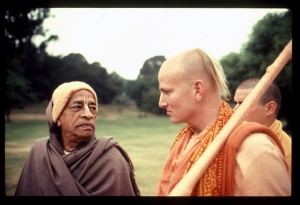SB 3.28.20

A.C. Bhaktivedanta Swami Prabhupada
TEXT 20
- tasmiḻ labdha-padaṁ cittaṁ
- sarvāvayava-saṁsthitam
- vilakṣyaikatra saṁyujyād
- aṅge bhagavato muniḥ
SYNONYMS
tasmin — on the form of the Lord; labdha-padam — fixed; cittam — the mind; sarva — all; avayava — limbs; saṁsthitam — fixed upon; vilakṣya — having distinguished; ekatra — in one place; saṁyujyāt — should fix the mind; aṅge — on each limb; bhagavataḥ — of the Lord; muniḥ — the sage.
TRANSLATION
In fixing his mind on the eternal form of the Lord, the yogī should not take a collective view of all His limbs, but should fix the mind on each individual limb of the Lord.
PURPORT
The word muni is very significant. Muni means one who is very expert in mental speculation or in thinking, feeling and willing. He is not mentioned here as a devotee or yogī. Those who try to meditate on the form of the Lord are called munis, or less intelligent, whereas those who render actual service to the Lord are called bhakti-yogīs. The thought process described below is for the education of the muni. In order to convince the yogī that the Absolute Truth, or Supreme Personality of Godhead, is never impersonal at any time, the following verses prescribe observing the Lord in His personal form, limb after limb. To think of the Lord as a whole may sometimes be impersonal; therefore, it is recommended here that one first think of His lotus feet, then His ankles, then the thighs, then the waist, then the chest, then the neck, then the face and so on. One should begin from the lotus feet and gradually rise to the upper limbs of the transcendental body of the Lord.